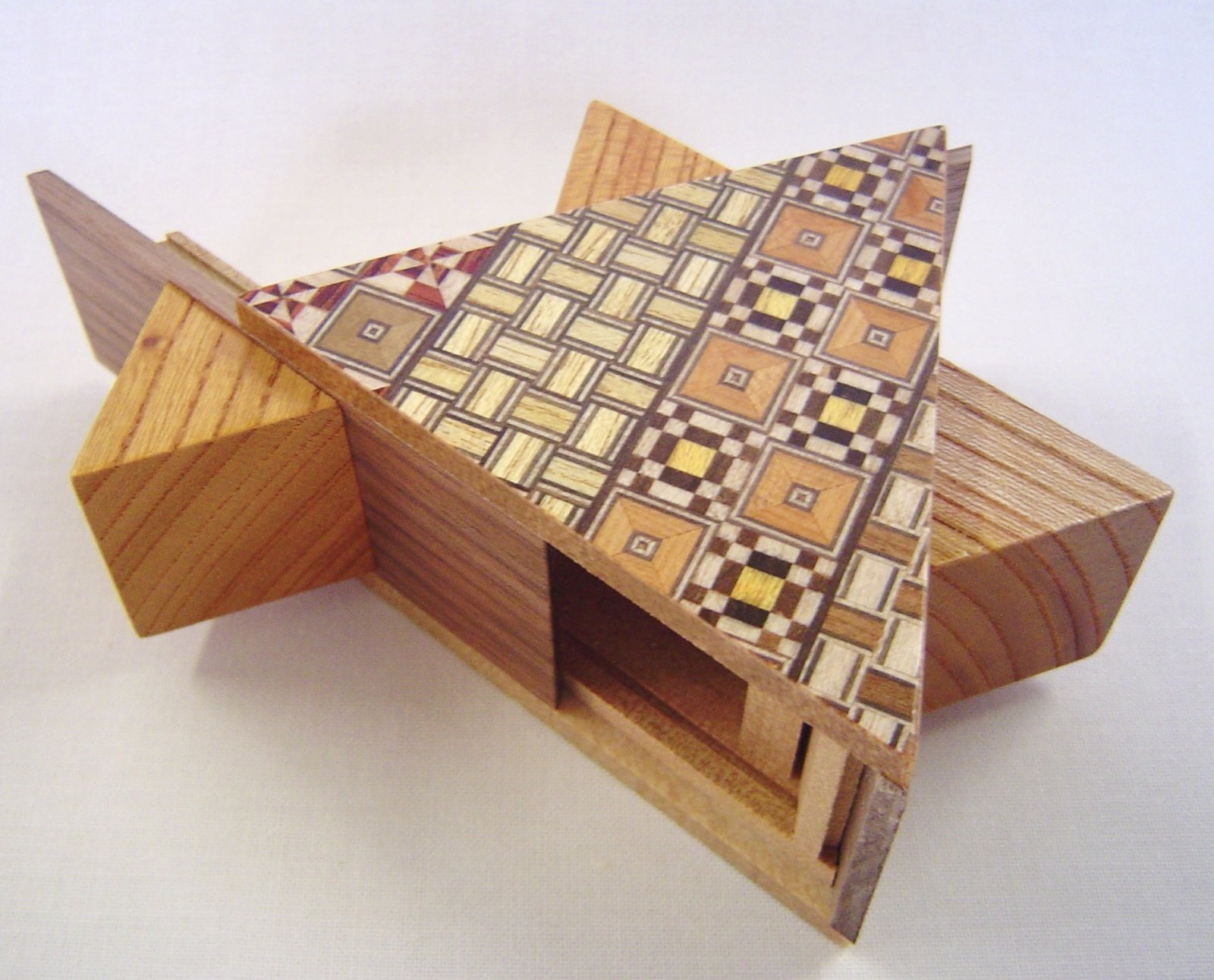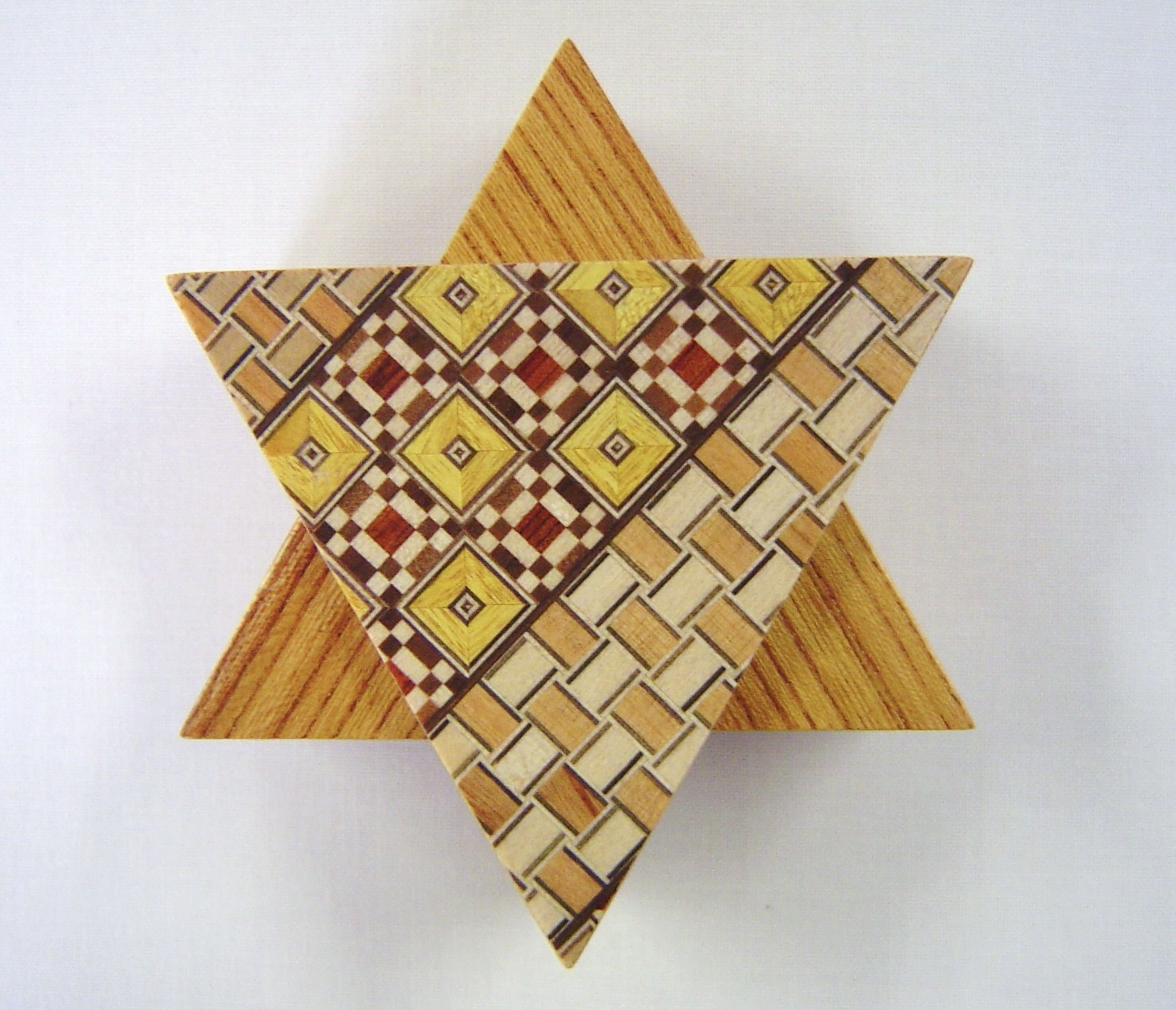Star box
Today, I spent my time on the finishing coat and final adjustments (movement checks) for the 4-sun 27-step box, so I didn't make progress on any other projects. In the afternoon, I went out for a bit and picked up some materials for production. So, for today, I'll share one of my past works. This is the "Star Box." Well, it's called a "Star," but the structure is actually a triangular puzzle box. So, the mechanism consists of 5 steps.
For those who may not know, I’ve made several polygonal Japanese puzzle boxes, including triangular, pentagonal, and hexagonal ones. That said, aside from the hexagonal ones, I haven’t made any others for about 10 years😅 The "Star Box" is one of these, where I added triangular blocks to a triangular puzzle box, giving it the shape of a "Hexagram." I made this box around 2010, during a time when I was frequently creating triangular puzzle boxes.
If my memory serves me right, I think I made the natural wood design of this box as a Christmas present for the Karakuri Creation Group. I often think about this box, probably because it's one of my favorites. Since this box has fixed triangular blocks, you can hook your fingers onto them to move the mechanism, making it very easy to operate. Normally, with triangular puzzle boxes (as with other polygonal boxes), you have to press the surface of the sliding panels to move the mechanism, which makes it a bit harder to operate. As shown in the picture, all the yellowish triangular blocks are attached to the Aruki panels, allowing you to press those parts to move the box. By the way, the triangular blocks in this picture are made of Keyaki wood.
I also like the shape of this box when it’s opened. It's a bit of an unnatural form. With regular puzzle boxes, only the panel slides, leaving the box in a more typical open state. But with the triangular blocks moving together, it creates a much more exaggerated, unusual shape compared to a normal puzzle box, which I find appealing. When the box closes, it returns to a neat hexagram shape, and I think this contrast is what makes it so interesting.
The most challenging part of making this box wasn't the box itself, but cutting out the triangular blocks. It was a bit difficult to cut all of them to the exact same size. Attaching the triangular blocks in the correct positions also required a lot of precision and care.
If I were to make this puzzle box again, I might make it a bit larger. It's definitely one of the pieces I'd like to reproduce someday😊
For those who may not know, I’ve made several polygonal Japanese puzzle boxes, including triangular, pentagonal, and hexagonal ones. That said, aside from the hexagonal ones, I haven’t made any others for about 10 years😅 The "Star Box" is one of these, where I added triangular blocks to a triangular puzzle box, giving it the shape of a "Hexagram." I made this box around 2010, during a time when I was frequently creating triangular puzzle boxes.
If my memory serves me right, I think I made the natural wood design of this box as a Christmas present for the Karakuri Creation Group. I often think about this box, probably because it's one of my favorites. Since this box has fixed triangular blocks, you can hook your fingers onto them to move the mechanism, making it very easy to operate. Normally, with triangular puzzle boxes (as with other polygonal boxes), you have to press the surface of the sliding panels to move the mechanism, which makes it a bit harder to operate. As shown in the picture, all the yellowish triangular blocks are attached to the Aruki panels, allowing you to press those parts to move the box. By the way, the triangular blocks in this picture are made of Keyaki wood.
I also like the shape of this box when it’s opened. It's a bit of an unnatural form. With regular puzzle boxes, only the panel slides, leaving the box in a more typical open state. But with the triangular blocks moving together, it creates a much more exaggerated, unusual shape compared to a normal puzzle box, which I find appealing. When the box closes, it returns to a neat hexagram shape, and I think this contrast is what makes it so interesting.
The most challenging part of making this box wasn't the box itself, but cutting out the triangular blocks. It was a bit difficult to cut all of them to the exact same size. Attaching the triangular blocks in the correct positions also required a lot of precision and care.
If I were to make this puzzle box again, I might make it a bit larger. It's definitely one of the pieces I'd like to reproduce someday😊

